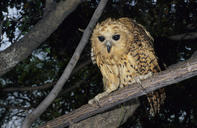
Name
Pel’s fishing owl -Scotopelia peli.
Pel’s Fishing Owl Appearance
The pel’s fishing owl is quite unmistakable, as the second largest owl found in South Africa, with its rufous plumage, with dark markings. This owl has no ear tufts and a rounded head. The eyes are large and dark in colour. The pel’s fishing owl has naked legs.
Diet
The pel’s fishing owl’s main food is fish, but will feed on frogs, mussels, insects and crabs. This fishing owl will also prey on small juvenile crocodiles.
The pel’s fishing owl can catch fish up to 2 kgs, but normally hunts small fish between 100 and 250 grams.
Pel’s Fishing Owl Breeding
The pel’s fishing owl is monogamous and territorial. They nest in a tree cavity around 6 m from the ground. The female will incubate her 2 eggs for around 32 days, with the male feeding her while she is on the nest. It is very rare for both chicks to fledge, with the norm being a single chick. The chicks are fledged at around 70 days, but remain in the parent's territory for around 10 months.
The pel’s fishing owl normally only breed every second year.
Pel’s Fishing Owl Behaviour
The pel’s fishing owl usually hunts at night, from a perch in a tree. The owl sits, watching the water and will swoop on to any fish that approaches the surface. This owl will also walk into shallow water to hunt. Once a fish is caught, the owl will return to its perch to consume the fish.
Pels fishing owls very rarely submerge themselves when hunting and rely on their large talons to catch fish.
Threats
The pel’s fishing owl is listed as vulnerable. The main threats for this owl are disturbance, pollution and river siltation.
Pel’s Fishing Owl Distribution and Habitat
The pel’s fishing owl can be found in forests that are close to water, like dams and rivers. This owl can be found in the eastern areas of Limpopo and KwaZulu Natal, in South Africa. They are mostly found in protected areas.